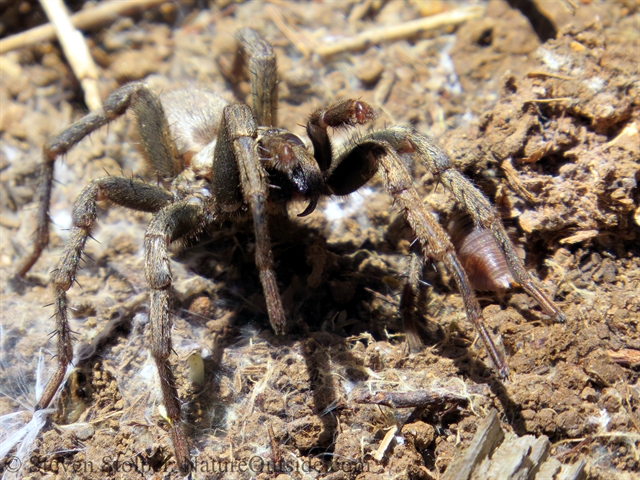
There’s not a cloud in the sky as I stroll the western foothills of California’s Santa Cruz Mountains. The sky is so dazzling it hurts my eyes. I pull the brim of my hat low and don my sunglasses as I stroll through a sward of native grasses.
Today I’m foraging, but not for food. I’m searching for wildlife. These coastal mountains are teeming with creatures great and small. And in a place like this you’re never alone. There are thousands of organisms within 10 feet of you.
I’m looking for reptiles and amphibians. And I’m going door-to-door in my neighborhood of non-human residents.
Learn by Lifting Rocks
Many people hike in the outdoors like visitors to a fine art museum. They walk along the trail as if separated by glass from the world around them.
But to connect with nature you must explore. You must indulge your curiosity like you did when you were ten years old. You must look into stumps and turn over rocks. Glance into pools and overturn leaves.
Lifting rocks can help you find reptiles and amphibians. But you must use proper technique. Stand behind the rock and lift it toward you, so the rock is between you and any venomous creature lurking beneath. Then replace it gently, in exactly the same spot. You want to preserve the seal that traps moisture underneath it. Or, you will destroy a refuge for the creatures beneath. And be careful not to crush the critters you were observing!
Calisoga Encounter
While searching for “herps,” my friend and I encountered a beast I’ve never seen before. The encounter was sudden and unexpected. You don’t lift a rock expecting to find a larger animal.
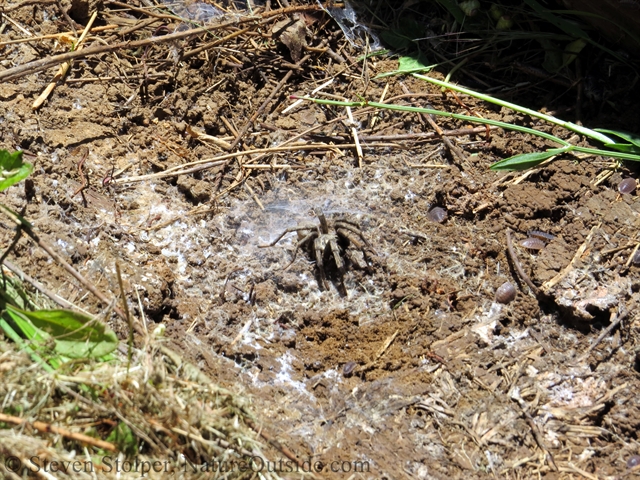
We find a Calisoga nest underneath a large rock. White silk lines the nest.
We find a Calisoga spider (C. longitarsus). It’s often called a False Tarantula or Velveteen Tarantula. This is a large spider – it’s body is close to 2” inches long. With enormous hairy legs, I was quite taken aback by my discovery.
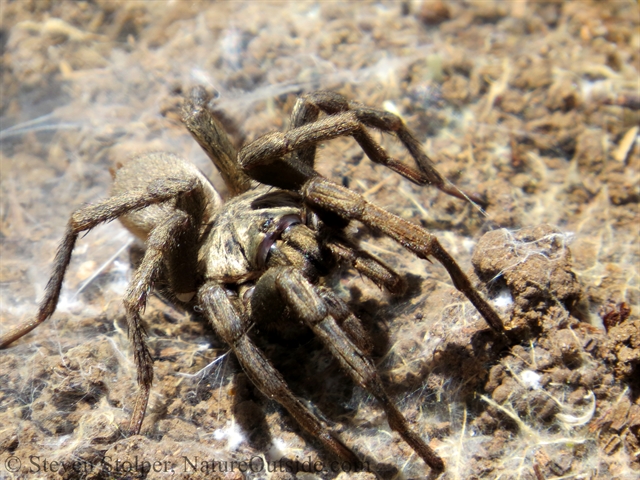
The Calisoga watches us, deciding what to do
These spiders live from sea level to 7,500 feet. They inhabit oak woodlands, forest clearings, and open grasslands.
Like Tarantulas, large fangs protect its front. Urticating hairs protect its rear. When threatened the spider can rub its hind legs on its abdomen to shed irritating hairs into the face and airway of an unwitting predator.
The Calisoga, like the Tarantula, is an ambush predator. It may remain in the area of its burrow for years at a time. As night falls, this nocturnal hunter lingers just inside the entrance to its burrow, waiting for prey to pass. Then, it lunges, using its front legs to scoop prey into its impressive fangs. The Calisoga retreats with the prey deep into its burrow to consume its meal.
Sometimes you see males wandering, looking for females after the first fall rains. But in general, it is rare to see one of these animals.
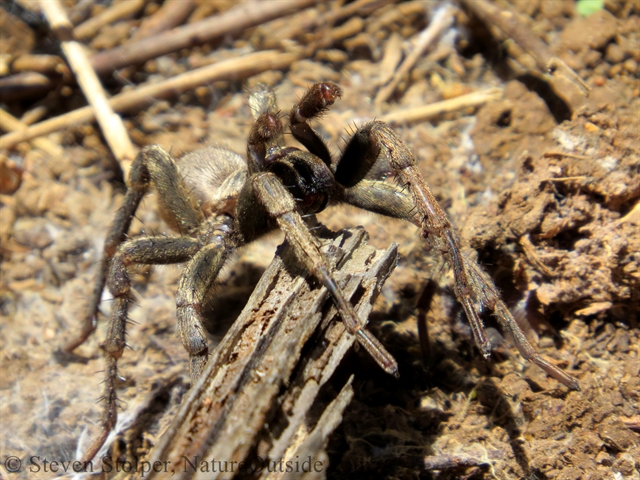
The Calisoga raises its front legs to expose its fearsome fangs
Get Out of My House!
The Calisoga is more aggressive than Tarantulas. When disturbed, they raise their front legs to expose their large fangs. It’s a fearsome display. And it quite intimidated me.
And the Calisoga has a reputation for being fierce. Unlike the more docile Tarantula, the Calisoga is quite willing to rear up and bite.

The Calisoga raises its front legs and exposes its fangs. It’s an intimidating display.
Their bite is not dangerous to humans. But it can be quite painful. The spider tracks my friend’s movements, fangs bared, as I snap some quick photographs.
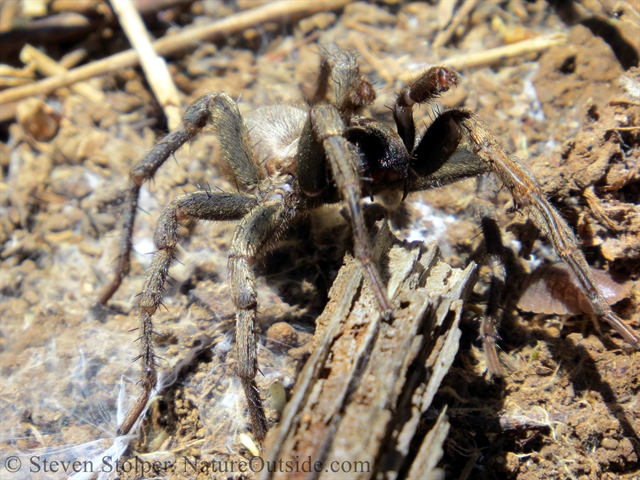
Calisoga defending its nest
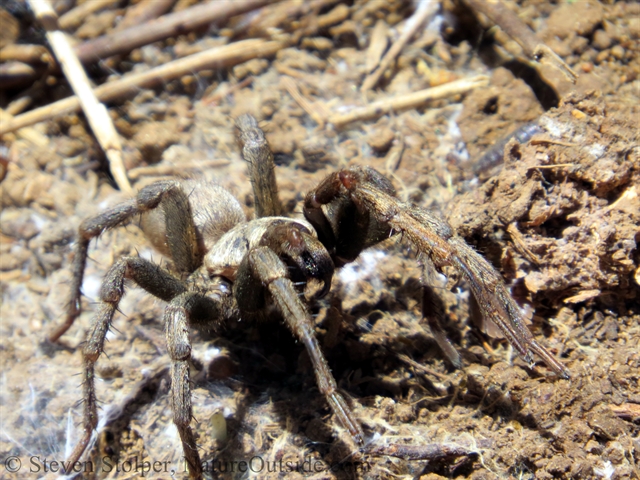
The Calisoga threatens two humans, who outweigh it more than a thousand times
I gently lay the rock back into place and continue my search, buoyed by my amazing luck.
Related Reading
This is an affiliate link.
Field guide to the spiders of California and the Pacific Coast States
Related Articles on NatureOutside
Urban Creatures – The Amazing Garter Snake
What in the World is an Ensatina?
For fun facts and useful tips, join the free Bushcraft Newsletter.



I think I encountered a calisoga in a stationary tub in our garage. I had turned the water on and what I thought was a tarantula came charging ou5 of the drain. I pointed at it with a paint stirrer and it reared up on its hind legs waving its front ones. We came back with a cardboard oatmeal tube, captured and released him in the corner of the yard. I suspect after reading your article it was a calisoga rather than a tarantula. Nice and informative as always, to read your articles.
Julie, I suspect you’re right. Now, for the next week I’m going to look in the drain before I step into the shower. 🙂
I came across one in a car port up in the hills in Truckee (Tahoe), at about 7000 feet. The dog found it first and jumped back as it darted at the dog, reared up on its back legs. I got it into a glass to photograph it. It was fairly big!! My first reaction was “I didn’t know there were tarantulas in Tahoe?!!!!” Let it go again back out into the night.
That’s a great story, Philip! They can look fearsome when they rear back like that. I’ll keep an eye out for them when I’m in the Tahoe area.
We encountered a big guy that looked a lot like this on the coast yesterday! Huge and showed its fangs the same way when we attempted to relocate him away from the waves. Just curious if it was indeed a false tarantula andwhy it was on the beach? Maybe a bird? Great post. Thanks for sharing.
Amber, I’m glad you enjoyed the article. You ask a terrific question. I do not know why the spider was on the beach. It may have been hunting isopods, amphipods, or insects that live on the sand. If you do a little research, you may be able to figure out the riddle. Tell me what you find out!
We have several Calisoga burrows in our yard. They are lined with spider webbing. Sometimes they leave a 1” web sack outside their burrow, like they have taken out the garbage. I can’t tell if it’s detritus from insects it has eaten or if it’s an egg case. There’s lots of the same tiny, tan, dry and fluffy bits.
That’s so cool, Nancy! You are lucky to have burrows near you.
I don’t know what’s in the web sack. You may want to come back from time-to-time to see if there are exit holes in the sack from hatchlings. Or, if you can see the bodies of insects as the webbing degrades over time.
I just found one of these under a door mat I left out to dry in the driveway! Santa Cruz foothills 🙂
Wow! That must have been quite a surprise, Monica. 🙂
I found one wrapped in silk and ejected from a slat in my living room wall where it was hanging like a baby bat. I carefully unwrapped it and had it identified by an entomology student at UC Davis- though I live in Santa Barbara in the mountains. She said it was odd because it was a female and they are not supposed to leave their burrows. My guess is that it had to flee the saturated ground after torrential rains this winter and ended up in our house. The big question is – what dispatched it? What kind of spider made a dinner of her? Not sleeping well these nights….
Yikes! I can imagine how freaky it is to find such a large spider in the house. If you’re right in thinking it sought refuge indoors, it may have died from starvation. In that case, you can sleep easier.
Nice writeup on the Calistoga spider.
Thanks, Hal! I’m glad you liked it.
I encountered one of these near the harbor in Santa Cruz. I was sitting talking with a group of people when we all suddenly heard agitated hissing sounds. We turned to look and saw a smallish looking tarantula with front legs raised and fangs exposed. I’d never seen a spider act like that before and was frozen fascinated watching it when suddenly another of our group ran up and smashed the spider with a brick.
Keith, thank you for sharing your story!
You were lucky to see one! It was probably protecting its nest.
It’s too bad one of your group felt they had to kill it. A lot of people are arachnophobic and just can’t help themselves. There was no way it would have been able to hurt anyone in the group unless they tried to touch it. It wasn’t really a threat.